Ford has been having some trouble persuading people who want to buy a truck to buy an electric truck.
While sales of the F-150 have remained as healthy as ever (the F-150 is the best-selling vehicle in North America) sales of the battery powered version of the same thing – the Lightning – have been sickly.
Probably because the Lightning isn’t the same thing, even though it looks almost exactly the same as an F-150 Super Crew.
It’s a very different thing, in fact.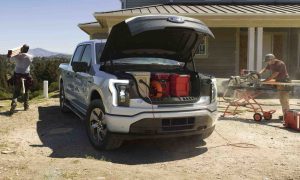
And therein lies what may be the rub: People interested in a traditional truck are not likely to be interested in one that isn’t. But people looking for something different may be.
The problem – for Ford – could be that the Lightning looks like what it isn’t.
And that works – or rather, doesn’t – both ways.
What It Is
The Lightning is a battery-powered full-size truck that looks like an F-150 SuperCrew cab half-ton truck.
But looks are – literally – skin deep.
The Lightning is different in so many ways, but it’s hard to tell by just looking. It has a trunk (and up front) for openers – which is something no traditional truck has ever had. There’s room to store stuff here, because there’s no engine under there.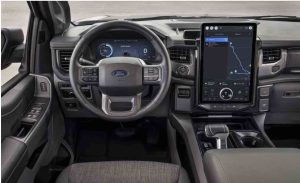
It also doesn’t have or even offer a two-speed transfer case, something all traditional trucks (including the F-150) have or offer, in order to be able to have 4WD low range. But the Lightning doesn’t need a transfer case – or even a transmission – because its electric motors drive its wheels directly and these motors produce so much torque that the gearing-down leverage advantage of a two-speed transfer case is unnecessary.
The Lightning does have a very heavy (about a ton, all by itself) battery pack that can only store about half as much energy as a gas tank. That’s why it doesn’t go as far as an F-150 – especially when pulling a trailer. It also takes much longer to get going again – because you can’t put electricity back into a battery nearly as quickly as you can pump gas into a tank.
These are negatives for people who need a traditional truck. Or rather, for people who assume that a vehicle which looks like a truck can be used in the same way that trucks traditionally have been used.
A Lightning is probably not going to work for such people.
But it might work for people who aren’t in need of a truck – but kind of like the idea of owning something that looks like one. That has a trunk. And that can used for other things, such as startling people who never imagined something that looks like a full-size truck could accelerate like a Ferrari.
With five people along for the ride.
Prices start at $52,090 for the base Pro trim, which comes standard with a 240 mile-range battery, full-time all-wheel-drive (unlike a traditional truck, which typically comes standard with 2WD – 4WD being optional) a 12 inch touchscreen and eight 120V household-type power outlets, four of them in the trunk up front.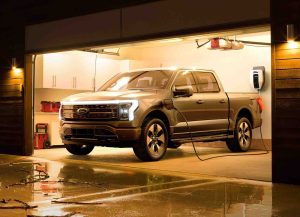
The next-up XLT lists for $59,590. This one gets carpeting (in place of rubber floor mats) and a leather-wrapped steering wheel. You can also buy – for about $10k more – the available long-range (320 mile) battery.
There’s a big price jump – to $79,590 – to get into the Lariat trim, which comes standard with a 20-inch wheel/tire package (18s are standard with the Pro), power seats, leather-wrapped steering wheel and seat covers, higher-load-rated accessory power outlets, heated and ventilated front seats, a larger 15.5 inch secondary touchscreen and an upgraded eight speaker Bang & Olufsen audio system.
A top-of-the-line Platinum lists for $91,995 and comes standard with the longer-range (320 mile) battery pack as well as most of the features that are optionally available with other Lightnings, plus massaging seats and an 18 speaker B&O premium audio system and a 10,000 lb. maximum trailer rating.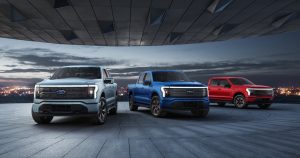
Regardless of trim, Ford only sells the Lightning in Super Crew cab/short (5.5 foot) bed configuration.
What’s New For 2024
A Flash trim has been added to the lineup for the Lightning’s third year in production. It slots above the XLT – and below the Lariat. It stickers for $72,090 and for that you get the longer-range battery (and the 15.5 inch display) standard. This one also comes standard with a new heat-pump system to improve cold-weather driving range by decreasing the energy draw to keep the Lightning’s cabin warm in winter and Ford’s BlueCruise semi-self-driving technology.
What’s Good
More protected storage space for cargo than a non-electric F-150.
Ferocious – and silent – acceleration capability.
Roomier – and much nicer inside – than a ’70s-era full-size American luxury sedan such as Cadillac Sedan deVille.
What’s Not So Good
Usefulness as a truck is greatly limited by the electric layout.
One-size-doesn’t-fit-all cab/bed configuration.
You could buy a base trim F-150 XL Crew Cab with a V6 – without the electric liabilities – for about $10,000 less ($41,530).
Unlike the F-150, which is a available with six different engines – including the standard 3.3 liter V6, an optional turbocharged 2.7 liter V6, an optional 5.0 V8, an optional 3.5 liter twin-turbo V6, a 5.2 liter supercharged V8 and a hybrid version of the 3.5 liter twin turbo V6 – the Lightning has two versions of the same basic electric drivetrain.
The standard set-up is a 98 kWh battery that provides up to 240 miles of advertised driving range. The dual motors (one for the front wheels, the other for the rear wheels) produce 452 horsepower and 775 ft.-lbs. of torque. These drive the wheels directly, so there is no transmission and no gears.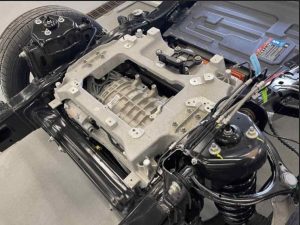
XLT and Lariat trims can be optioned with a more powerful 131 kWh battery pack that ups the maximum advertised range to 320 miles and the output of the electric motors rises to 580 horsepower.
Like most electric vehicles, the Lightning can be recharged at home using any household-type 120V power outlet. However, charging the vehicle this way can take days rather than hours. For this reason, it is a functional necessity to have your home’s electrical system upgraded to allow for what’s called “Level II” charging, which means having an electrician wire up a dedicated 240V (and typically 30 amp) outlet close enough to wherever you park the vehicle so as to be able to plug it in.
Level II charging takes about eight hours.
The third option is to use a public “fast” charger, which is faster than Level II charging (and much faster than Level I charging) but not always and not to full. Because of the high-voltage, “fast” charging is limited to partial charging – up to 80 percent of capacity, typically – and even that takes about half an hour or longer.
Some “fast” chargers are also slower than others – depending on their power output capacity. And depending upon how many other EVs are drawing power at the same time.
Something else to be aware of as regards “fast” chargers is that you cannot pay cash for power. These kiosks only take credit/debit cards and many of them will not let you charge your charge without using your phone – onto which you must download an app.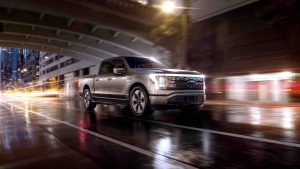
On The Road
Driving an electric truck is like driving an electric car that’s bigger – and can carry more people. And that may be the right way to look at the Lightning. That is, not as a truck but as a large-sized people mover.
Most EVs can’t seat six – or even five, comfortably (say it ’80s-era Japanese style) because they’re cars and they’re just not large enough to seat that many comfortably, as large American cars once were. Trucks like the F-150 have largely taken over this role because there are no large cars anymore. Even today’s “full-size” cars are small by the full-size standards of the’70s – and none of them have trunks that can carry 5-6 people’s things.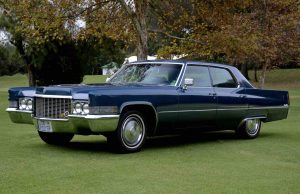
The Lightning can. This makes it more practical as a passenger vehicle than the F-150, which lacks the trunk up front.
And it can carry all of those people – and all that stuff – very quickly. The Lightning is nearly as quick as the quickest version of the F-150, the Raptor R – which is the one with the supercharged 5.2 liter V8 (more about that one, here).
But it gets to 60 in 4 seconds – vs. about 3.7 for the Raptor R – nearly silently. You hear a background whirring/winding sound, which is the sound of the motors spooling up. And then there’s the surge of continuous acceleration. It’s very much like the way a jet aircraft feels on its take-off roll, just without the sound of the engines.
But keep your eye on the range indicator. Not the charge remaining indicator.
The latter may say you have 53 percent charge remaining, which instinctively comes across much the same as a half-full tank. But you’ve only got about 111 miles of range remaining – which is the rough equivalent of less than a quarter-tank to go before empty, in a gas-engined vehicle.
And it’s actually not that much, because the actual vs. indicated range remaining in an EV is very often less than indicated – typically by about 10 percent – and because with battery-powered vehicles, running it down to empty is bad for the battery and possibly for you, in that it is not easy to walk a few kilowatt-hours of electricity back to an empty EV.
None of the above is necessarily a problem if you don’t need the Lightning to go the distance – so to speak. Or pull a trailer more than short-distances, as doing this can reduce the actual range you can pull by 50 percent.
In other words, if you don’t expect the Lightning to do “truck” things – and look at it as an electrically-powered version of the big sedans Americans used to wheel around in – it makes a lot more sense.
Ford might give thought to marketing the Lightning’s strengths as a conveyance rather than trying to sell it as a truck.
At The Curb
Honda showed that there is a market for a truck (the Ridgeline) that isn’t one, but looks like it is. The reason being not everyone wants a truck – but many do like the look as well as having some of the attributes, such as a bed out back that can be used to carry things that would never fit inside a car (or a crossover).
The Lightning has the bed plus the trunk – as well as the look.
What it lacks (like the Ridgeline) is the variety.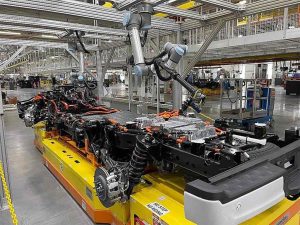
The Lightning’s Super Crew Cab/short bed-only configuration is probably a necessity in that the length of this layout (232.7 inches vs. 209.1 for a regular cab F-150 with a 6.5 foot bed) is needed to house the battery, which is enormous as well as enormously heavy. The weight needs to be spread out over that length to avoid too much weight here and not enough there. But this one-size-fit-all configuration takes away one of the F-truck’s most desirable attributes – that being you can get one to suit. Regular cab – and long (eight foot) bed. Or extended cab, with a six foot bed. Whatever you need, just about. And not everyone who might otherwise like the Lightning wants – or needs – a Super Crew cab.
And may want more bed.
This brings up a related point, which is the cost – and that’s also a function of one-size-fits-all. Though the base Pro trim is marketed as the “work truck” version of the Lightning, it is a much more expensive truck than the regular cab work truck version of the non-electric F-150, which lists for $34,885 to start. That is almost $20k less to start than the Lightning Pro.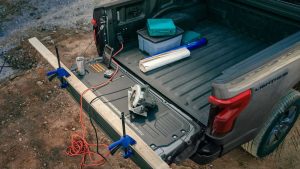
On the other hand, a base trim non-electric Super Crew cab F-150 stickers for $41,530. That’s still about $10k less than the base price of the Lightning Pro.
But it’s not almost $20k less.
The Rest
Though the Lightning looks almost exactly like a regular F-150 Super Crew, there are a few subtle differences, including the absence of a gas door in the usual place (rear quarter panel) and the presence of a charge door in a new place (driver’s side front fender). 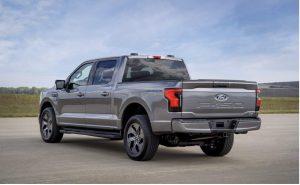
There are also the available high-amp accessory outlets in the bed. These are unique to the Lightning – which has the electrical power on board to power welders and air compressors. But keep in mind that using them will draw power from the battery, leaving less power to power the Lightning, itself.
The Bottom Line
The Lightning might sell better if it were marketed differently than something that looks like a truck.
. . .
If you like what you’ve found here please consider supporting EPautos.
We depend on you to keep the wheels turning!
Our donate button is here.
If you prefer not to use PayPal, our mailing address is:
EPautos
721 Hummingbird Lane SE
Copper Hill, VA 24079
PS: Get an EPautos magnet or sticker or coaster in return for a $20 or more one-time donation or a $10 or more monthly recurring donation. (Please be sure to tell us you want a magnet or sticker or coaster – and also, provide an address, so we know where to mail the thing!)
If you like items like the Keeeeeeev T shirt pictured below, you can find that and more at the EPautos store!





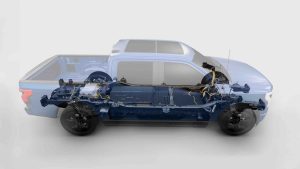







I actually am of the thinking the Ford Lightning package could actually work as a resurrected Lincoln Town Car or Crown Victoria: Such a car would have the size and space to carry six people, their luggage, and the requisite yooge battery pack.
Like the IC originals, it’d sell well as a taxi, executive car, or limo. Taxis, “black cars,” and limos make lots of short trips in urban areas, can be rotated in and out of service as some are charging, and as EVs, emit no smog (at least at their nonexistent tail pipes).
Yeah, they’d have the same EV problems of auto-da-fe, expense, range, and charging. But I can see many people who’d go for an electric Town Car/Crown Vic.
Why Ford didn’t think of this, I’ll never know.
taxi, executive car, or limo’s must stay on the road all day in order to make financial sense.
No way these are staying on the road all day, maybe 1/3 to 1/2 the day?
I searched for a “standard” truck — 2 doors and an 8 ft bed. Finally got a 2019 F150.
I can’t carry little kids (no back seat), but I can carry a load of Railroad cross ties or a cord of firewood.
A simple 4kw gas generator is $400. It fits in what’s left of F 150s bed . It runs a compressor and welder. This here lightnin bug is just another snob trrrrrrrinket. How you got thru this review demonstrates commendable professional objectivity.
The third option is to use a public “fast” charger, which is faster than Level II charging (and much faster than Level I charging) but not always and not to full.
It’s preferable to say that an EV charger is “not quite as slow as” another EV charger. After all, “faster” is the comparative of “fast”, and as we know there is no such thing as a fast EV charger.
I guess ford at least should get some kudos for having EP review it.
Ford has no excuse for not having fixed the charging time and range issues of the Lightning so that it would have been on parity with the refuelling time and driving range of the regular F-150 once it was launched in the marketplace. There may be explanations for why Ford did not fix these problems, but those explanations do not constitute excuses.
There are also the available high-amp accessory outlets in the bed. These are unique to the Lightning – which has the electrical power on board to power welders and air compressors.
The hybrid drivetrains also have the big inverter in the bed. They should be sending you a Platinum hybrid to test, but I’m guessing they don’t need to do much convincing to get people to buy them. Imagine if you did a lot of RVing. Between the improvements in solar and LiFePo house batteries and an F150 with Pro Power Onboard you could skip out on hooking up at a trailer park completely, at least until you had to dump.
Hi RK,
Yup!
I’d like to get into RV’ing. I’ve not had any luck getting through to the various manufacturers, though. It seems to be a world unto itself…
I’m constantly on the fence myself. When I had income to buy I didn’t have the time. Now that I have the time I don’t have the income. Buying used is such a crapshoot unless you know the seller’s behavior. Most of the stuff on the secondary market is clapped out or otherwise needs a lot of work to make habitable. And new is crazy expensive and still subject to waiting lists to get what you want.
Check out the large end of year RV shows. The deals may be limited to stock at the show but you can get huge mark downs.
There are a decent amount of people who trade in RVs every two years because they have to have the latest & greatest. These trade in are usually only found at dealers.
If you are out west, your choices are less than eastern US.
Hi RK, just my opinion, but you’re probably better off buying a used one. No matter the brand, most RV’s and campers are built with shit quality. Not unusual for them to have leaks, doors that don’t close right, stoves or faucets that don’t work, etc. etc. etc. Warranty work is notoriously bad, with some having to wait 6 to 9 months or even a year to get their rigs repaired. I’ve found that it’s best to buy one that’s 2 or 3, maybe even 4 years old. New enough that there shouldn’t be a lot of wear and tear, but at that point someone else has almost certainly ferreted out all the little problems and fixed them. I think there will be some great deals in the next year if you have some cash. Too many people ran out and bought during the pandemic, while credit was easy and interest rates were low. Now they want/need to get rid of it. I understand that there’s a glut, and prices are starting to crash. And, like everything else in soon to be 3rd world America, it’s only going to get worse.
except towing an rv w a lightning would only get you around 80-100 miles down the road, and it would be empty empty. I can see it coming at an RV park “hey you!!!! you can’t charge your truck here” hahah………….
F-150 Platinum is a hybrid, not an EV.
ahhhh, sorry about that.
Ford needs to hand out a cheatsheet for all the F150 models.
Heck, a big grid sheet for all their trucks. What’s the difference between an F-250 and F-350? I think an F-550 is the dualie but then again I’m pretty sure I’ve seen F-250 Superduty dualies too. Maybe a task for the AI?
‘Sales of the Lightning have been sickly.’ — eric
Let’s have some fun with maff.
‘In the United States, Ford F-Series deliveries totaled 186,974 units in Q3 2023. Of these, Ford F-150 Lightning sales totaled 4,291 units.’ — fordauthority.com
Ford doesn’t break down F-series sales into F-150, F-250, F-350, etc. But it does publish production figures. In 2022, F-150 production was 61% of all F-series production. So we’ll apply 61% to third quarter F-series sales, to estimate F-150 sales:
F-150 sales (3Q): 186,974 x 0.61 = 114,054 (est.)
So, F-150 Lightning sales of 4,291 units were (4,291 / 114,054) or 3.76% of all F-150 sales.
The notorious ‘Jim H wager’ claims that F-150 Lightning sales will NEVER exceed ten percent of all F-150 sales, absent new restrictions on the sale of internal combustion F-150s.
Ford is nowhere near making me pay off on that bet. As Americans used to say back in Model T days, the F-150 Lightning is a drug on the market. Ford (and its fickle master, the US fedgov) is pushing on a string, trying to cram this crap down our throats.